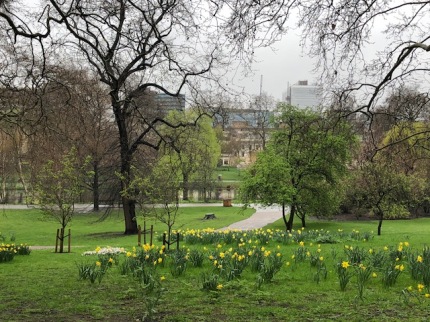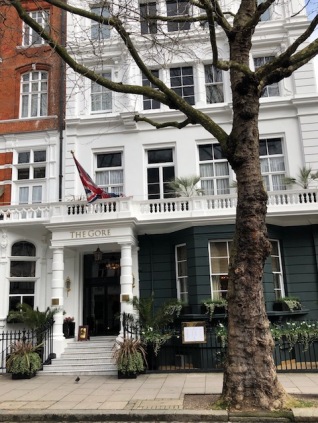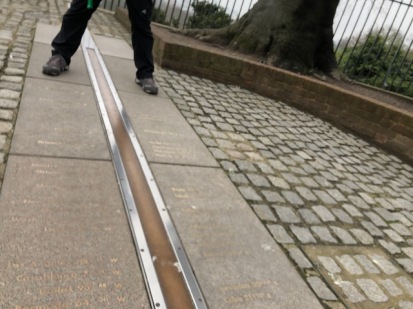I fell in love with London on my first visit—but not in the traditional way. In 1993, I spent the summer blissfully backpacking through Europe. By the time I arrived in London at the end of August, I was utterly exhausted and ready to go home to the United States. I practically hugged the immigration inspector who spoke to me in English, my mother tongue. The inspector forced me to enter the country so I would stop talking to him.
Until my flight left for the United States, I had an amazing time in London sleeping, eating Taco Bell, and watching American movies without subtitles. That’s all I did. No museums, no history, no art.
I apologize, London, for my poor behavior during my last trip. In an attempt to make things right, my husband and I spent five days in London at the beginning of April 2018. Obviously, I am not a London expert. There are as many itineraries as there are travelers. This one is mine.

April in London
Day 1: Windsor Castle/Victoria and Albert Museum
We arrived in London by car after spending a week in the Cotswolds. On the drive to London, we stopped off at Windsor Castle. We made it to the town of Windsor and saw a fairy-tale castle perched on the hill. Then I tried to park.
Windsor has many parking lots. I know. I visited all of them. Every single one is overfilled with cars and fun signs warning that any belongings left in your car will be stolen whilst you visit the castle. When you finally do find a spot, you discover that the parking meters: 1) Eat (steal) your money, and 2) Do not work with the parking app on your phone. As a last resort, I called a phone number listed on the meter, and was hung up on twice, but only after racking up $10 in international phone charges.
At some point, it is important to listen to the universe. Clearly, Windsor Castle was not to be. We drove on to save me from tears of frustration.
Tips for Parking in Windsor:
* Bring cash. A lot of cash. In small denominations.
* Don’t attempt to park with suitcases in your car, as, apparently, they and everything else you own will be stolen.
* Don’t go on a Saturday, because Saturday was REALLY busy.
* Find every parking app for England and download all of them before your trip.
* Arrive early in the day so that you can devote an enormous amount of time and energy looking for parking.
* Take the train.
That, my friends, is how we arrived in London several hours ahead of schedule! As a silver lining, we had time to visit the Victoria and Albert museum, which was located a few blocks from our hotel in Kensington Gardens.

The Gore Hotel
According to the Victoria and Albert Museum website, it “is the world’s leading museum of art and design, housing a permanent collection of over 2.3 million objects that span over 5,000 years of human creativity.”
Every once in a while, I am truly surprised while traveling. I had such a moment in the Victoria and Albert Museum. I randomly walked into a room and found myself surrounded by an astounding richness of famous art, including Michelangelo’s David, the doors of the Florence Cathedral, and Trajan’s Column, to name a few. I had wandered into the Cast Courts rooms.
The Cast Courts opened in 1873, and allowed for the in-depth study of these famous objects through plaster cast reproductions. As a bonus, Londoners who could not afford to travel still had the opportunity to experience these works of art. I LOVED this concept—if you can’t see the world, bring the world to you.
Hotel Tip: I don’t recommend many hotels, because I am not often inspired by them. However, I adored the Gore Hotel near Kensington Gardens. It has a perfect blend of historic ambiance and modern amenities.

Kensington Gardens
Day 2: Churchill War Rooms/Claridge’s
The War Rooms comprised Winston Churchill’s underground command center during World War II. Visitors catch a glimpse into the daily lives of the men and women who worked and often slept at this site. In addition to the tour of the War Rooms, which have been preserved in their original World War II condition, the site also contains the Churchill Museum.
Tips for Visiting the War Rooms
Buy your ticket in advance, because they sell out. Arrive at opening time.
Go directly to the Map Room. The Map Room, where England’s leaders tracked and strategized military moves, is the star of the War Rooms, and it is at the very end of the self-guided tour. We went directly to the Map Room upon arrival and had the place to ourselves, but only because we were some of the first visitors of the day. We then worked backwards and ended at the Churchill Museum.
Give yourself plenty of time. The website reports that it will take 90 minutes to see the site, but we were there for over three hours.
After building up an appetite at the War Rooms, we had reservations for afternoon tea at Claridge’s Hotel. This 5-star hotel opened in the 1800s and has been serving one of the fanciest afternoon teas in London for approximately 150 years. During our travels the previous week, I had spent two hours at an owl habitat in the Cotswolds to make my husband happy. Let me be clear: I spent two hours watching the staff feed owls with bloody, baby chicken heads. Now, we were going to spend two hours at a fancy tea for me. This is how a successful marriage works.
Afternoon tea usually includes little tea sandwiches, scones, clotted cream, and miniature, delicious desserts. If you are like me, you also pay extra for a glass of champagne. Some teas can be relatively inexpensive, but one pays an obscene amount of money for the ambiance, service and civility at a location such as Claridge’s. After the owl encounter, I deserved every pricey moment.

Tea Time at Claridge’s
Tea Time Tip:During the planning for this trip, I realized that I had made the American mistake of mixing up the terms high tea and afternoon tea. According to TeaTime Magazine, high tea is a substantive, but light, meal served in the early evening and can include “meat, fish, and egg dishes, as well as breads and desserts. …High tea gets its name from its tendency to be served at a high table, like a dining table or high counter, at the end of the workday. ” Afternoon tea, however, is what we had at Claridge’s—tea sandwiches, scones, desserts.
I know, my fellow Americans. Your minds are blown with these new facts. You’re welcome. I am assuming our British readers are not impressed.
Day 3: Hop-On, Hop-Off/Royal Mews/St. Paul’s
Day three began with a hop-on, hop-off bus tour of London. Don’t give me that look. These bus tours are touristy, but I am a tourist. Sadly, these tours do not work in London. The sites are too spread apart, and there is too much traffic. I would only recommend the bus tour if your idea of a good time is sitting in traffic choking to death on car fumes. We called it quits and hopped off the bus.
Instead, we took some obligatory photos in front of Buckingham Palace and enjoyed the art at the Queen’s Gallery. The museum is small and uncrowded, and it houses a rotating display of the royal family’s art collection. While there, I bought an expensive Prince Harry and Meghan china coffee cup in the gift shop, as royal wedding fever was running high. Yes, I did buy that mug. I hand-carried it home as if it were a baby.

Royal Wedding Mug
Continuing with the royal theme of the day, we walked over to the Royal Mews, which is home to the vehicles and carriages used by the royal family. I have a fondness for royal carriages. They are more than a means of transportation. Royal carriages are chock full of history, national symbolism, and are works of art in their own right. The most impressive carriage in the collection is the Gold State Coach, circa 1760, which is drawn by eight horses and was used by Queen Elizabeth for her coronation.

Royal Carriage
We made our way to St. Paul’s Cathedral. St. Paul’s was a “must-see” for me in London. More than its beauty, I wanted to pay tribute to this cathedral that was a symbol of national endurance during World War II. During the Blitz in 1940, the St. Paul’s Fire Watch saved the cathedral, even as historic buildings burned around it. Some hypothesize that St. Paul’s survived the war because the Nazi bombers needed it as a navigational aid in the city darkened by mandatory black-outs. Others point to the fact that Churchill directed St. Paul’s be defended for the morale of the people. Either way, the cathedral stood as a beacon of hope for the brave people of London throughout the war.

St. Paul’s Cathedral
St. Paul’s was built by the famous architect Sir Christopher Wren in the late 1600s. It is a majestic building full of history and art. The self-guided audio tour is outstanding, and includes many options to “learn more” about a particular topic. I listened to every bit of the audio guide while climbing to the top of the dome to enjoy the views of the city. While climbing the dome, I stopped to rest at the first gallery and was treated to a choir singing below us. The gorgeous music rose up to meet me at my vantage point high above the cathedral floor. It was one of those wondrous, unanticipated moments of travel that creates a memory of a lifetime.
Restaurant Tip: Memories of India, a restaurant near Kensington Gardens at 18 Gloucester Road, serves fantastic Indian food. It is popular, so make a reservation!
Day 4: Harry Potter Studio Tour/Tower of London
Ahh, the good stuff—the Harry Potter Warner Brothers Tour. There was so much to report that I wrote a separate post about it. Please see: Which Harry Potter Experience? The United States or London? Suffice to say, you should partake of this fabulous studio tour if you are a Harry Potter fan. Don’t think about it. Just do it.

Harry Potter Studio Tour
At twilight, we made our way over to the Tower of London, which has at various times served as a castle, a treasury, and a prison. The Beefeaters, who are Tower of London guards (Yeoman Warders), led us on an entertaining and historical tour. The Beefeaters enjoy making fun of people from other countries, especially Americans. To be fair, the Beefeaters can’t help it if Americans give them an abundance of comic material to use.
The most important part of the evening was the Ceremony of the Keys. This is a solemn ritual to secure the gates of the Tower London, and it has taken place every evening for the past 700 years. Tourists can make reservations for this ceremony on the Tower of London website, but the spots are booked up a year in advance! The Ceremony of the Keys is an anomaly in our modern world—there are no fireworks or multi-media presentations. Perhaps for that very reason, I immensely enjoyed observing this tradition that harkened back to an earlier age. Please note that these evening tours do not permit entry to the crowned jewels. A friend of mine was recently disappointed when she discovered this fact.

Tower of London
Day 5: Greenwich Royal Observatory/Westminster Abbey
Our choice of activity for day five is a bit suspect. In my head, I planned to take a quick boat ride to Greenwich, stand on the Prime Meridian, and then hop back to London for a full day of museum activities. Here is the thing: the greater London area is huge. We constantly underestimated how long it would take to navigate between the sites we wanted to see.
So, day five became ALL about Greenwich and the Prime Meridian with little time for anything else. We took a boat with a live guide to get to Greenwich. Regretfully, the ride was a wee bit boring, as there isn’t a lot to see on the way over.

Standing Astride the Prime Meridian
The Royal Greenwich Observatory itself provides impressive exhibitions dedicated to the Prime Meridian, Greenwich Mean Time, navigation, and astronomy. Simply put, the Prime Meridian divides the earth between the Eastern and Western Hemispheres. The National Geographic website notes that before establishing the Prime Meridian, “Navigation at sea was extremely difficult, resulting in countless disasters and disappearances over the centuries because ships’ captains simply could not figure out where they were.”
The time kept at the Royal Observatory, known as Greenwich Mean Time, also became a standard by which time across the world was coordinated. Before Greenwich Mean Time, each city and town kept its own local time, which made it difficult to plan things like train journeys in an age of industrialization.

The Royal Observatory
I highly recommend visiting the town of Greenwich and the Royal Observatory, which was built by architect Christopher Wren. However, unless science is your passion, I would not make Greenwich a priority on your first visit to London if you don’t have a lot of time. Come back and see it on a subsequent visit.
Please note: My husband was outraged at the thought that anyone would miss the Royal Observatory based on my review. He defiantly said that he could have spent more time there, and that he liked the boat ride, and that no one who has any brains should delay going there. Soooo, there’s an alternate opinion for you to consider…
Pub Recommendation: We ate that The Plume of Feathers in Greenwich. It was a traditional pub that warmed us up on a chilly day.

The Plume of Feathers
We ended our time in London with a quick stop at Westminster Abbey, which is open late on Wednesdays until 6 pm. St. Paul’s Cathedral was elegant, impressive, and inspirational. Westminster Abbey, in comparison, was a bit like visiting an elderly hoarder who has lived in the same house since 960 AD.
I enjoyed our time visiting the tombs placed helter-skelter in every nook and cranny throughout the Abbey. They represent a mind-boggling number of important people in history—royalty, statesmen, artists, scientists, etc. However, the crowds of people and the chaotic interior of the Abbey were a bit overwhelming for the senses. I am guessing that Westminster Abbey is a more manageable if you are the first to arrive when it opens, or if you visit the Abbey during the quiet times reserved for worship.
Bonus: Day 6: Kensington Palace
We didn’t really have a day six, but I did manage to squeeze in some time at Kensington Palace before our plane departed. The palace is easy-walking distance from the Gore Hotel. I walked through the delightful (and immense) Kensington Gardens and took the self-guided tour of the palace. The displays in the palace were understated and educational, and offered additional insights into the lives of the royal family. Kensington Palace provide a lovely spot overlooking the gardens for tea, where I indulged in a last scone and clotted cream.

Kensington Palace Garden
To read more about our adventures in England, please see:
Stonehenge and Avebury: A Day in Neolithic England
How To: Drive on the Left Side of the Road
